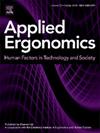Proprioception and vision relationship in aimed movement with restricted and reversed vision
IF 3.4
2区 工程技术
Q2 ENGINEERING, INDUSTRIAL
引用次数: 0
Abstract
Human movement relies on visual and proprioceptive inputs, and the movement can be hampered when either input provides limited or distorted information, as in robotic surgery, virtual reality, or spaceflight. This study examines how proprioception influences performance in aimed movement tasks under restricted and inverted visual conditions. An experiment with 24 participants showed slower movements and increased information processing demands with incompatible visual feedback. The difference was diminished when the proprioceptive variability was controlled through ANCOVA. The findings allude to the necessity of considering individual differences in proprioceptive ability when evaluating performance across different visual conditions. These results can help develop training protocols and design interfaces when visual and proprioception sensory feedback are incompatible. Also, continuous visual feedback of hand movement may not be necessary. Instead, a correctly sized visual window of the target is sufficient for aimed movement tasks. This result has practical implications, especially when optimizing VR renders.
受限视觉和反向视觉的瞄准运动本体感觉与视觉关系
人类的运动依赖于视觉和本体感觉输入,当输入提供有限或扭曲的信息时,比如在机器人手术、虚拟现实或太空飞行中,运动可能会受到阻碍。本研究探讨了在受限和倒置视觉条件下本体感觉如何影响目标运动任务的表现。一项有24名参与者参与的实验显示,在视觉反馈不兼容的情况下,他们的动作变慢,信息处理需求增加。当通过ANCOVA控制本体感觉变异性时,差异减小。研究结果暗示,在评估不同视觉条件下的表现时,有必要考虑个体本体感觉能力的差异。这些结果可以帮助开发训练协议和设计界面时,视觉和本体感觉反馈不相容。此外,手部运动的连续视觉反馈可能是不必要的。相反,一个正确大小的目标可视窗口对于目标移动任务来说是足够的。这一结果具有实际意义,特别是在优化VR渲染时。
本文章由计算机程序翻译,如有差异,请以英文原文为准。
求助全文
约1分钟内获得全文
求助全文
来源期刊

Applied Ergonomics
工程技术-工程:工业
CiteScore
7.50
自引率
9.40%
发文量
248
审稿时长
53 days
期刊介绍:
Applied Ergonomics is aimed at ergonomists and all those interested in applying ergonomics/human factors in the design, planning and management of technical and social systems at work or leisure. Readership is truly international with subscribers in over 50 countries. Professionals for whom Applied Ergonomics is of interest include: ergonomists, designers, industrial engineers, health and safety specialists, systems engineers, design engineers, organizational psychologists, occupational health specialists and human-computer interaction specialists.
 求助内容:
求助内容: 应助结果提醒方式:
应助结果提醒方式:


